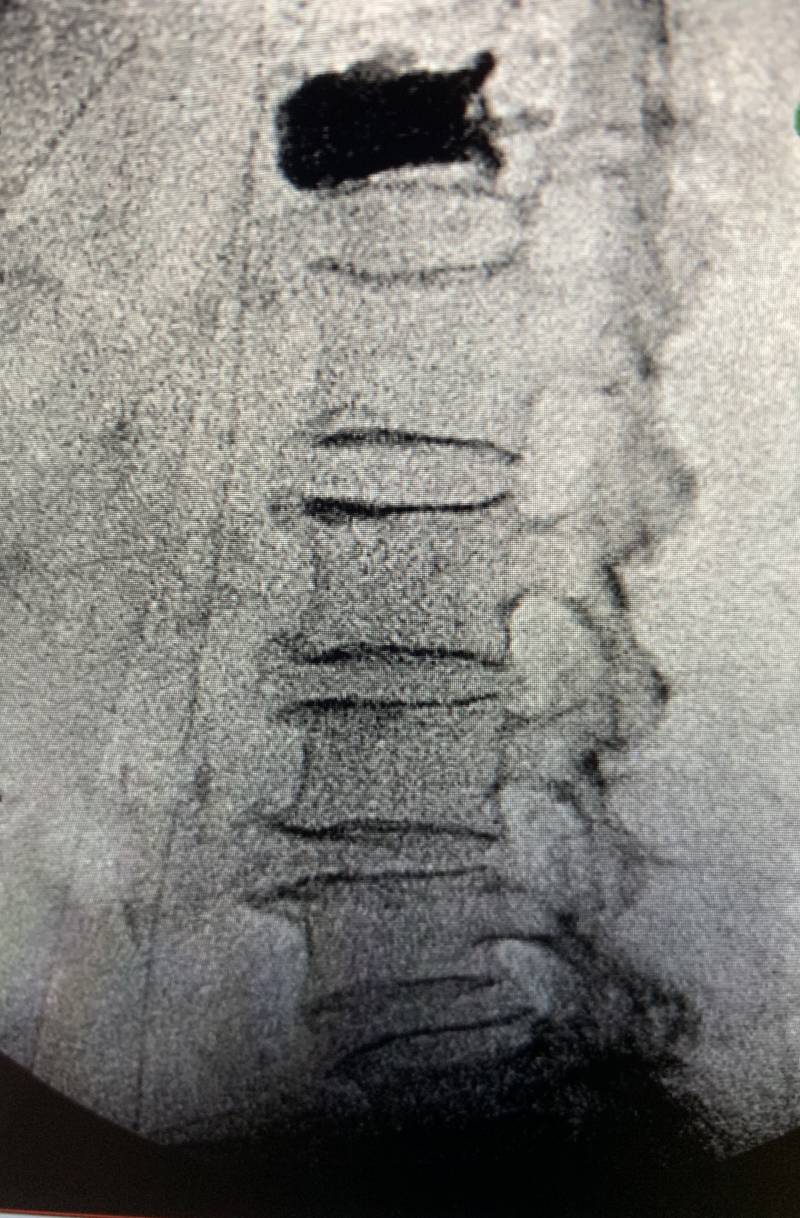PMMA, or polymethylmethacrylate, goes by a number of names, including acrylic, acrylic glass, Perspex, or plexiglass. It is both a lightweight and shatter-resistant alternative to normal glass. PMMA’s potential for medical use was discovered during the Second World War, when it was found that RAF pilots whose eyes had been pierced with splinters of PMMA did not reject or react strongly to the material.1 The first intraocular lens made of PMMA was implanted in London in November of 1949.2 Since then, there has been a long history of use of PMMA in medical procedures, particularly for spine procedures.
PMMA finds versatile use in a number of spinal procedures, including fixation of osteoporotic spines. Patients with osteoporosis or vertebral fracture may suffer from severe spinal instability, which can be treated by stabilizing the vertebrae using bone cements, metals, and other inert materials. One study found that using PMMA-augmented cannulated pedicle screws during surgery reduced operation time and cement leakage rate when compared to the control needle-injection group.3 Moreover, patients who received PMMA-augmented cannulated pedicle screws reported reduced pain (with the mean visual analog pain score dropping from 9.5 to 3.1) as well as a 42 percent reduction in functional Oswestry disability index score. Several other studies have shown that PMMA-augmented pedicle screws demonstrate increased strength and stiffness as compared to non-PMMA-augmented screws, making them a more desirable biomaterial for this procedure.4
PMMA also can be used for spinal reconstruction following vertebral body resection of metastatic tissue. The excised portion of the vertebrae may be restored using any number of materials, including PMMA, interbody spacers, bone autografts, and/or cages.5 Other internal devices are necessary to augment the fixation of PMMA when it is used for reconstruction: for example, an anterior cervical plate. One study demonstrated surprising success of using a titanium cage-assisted PMMA reconstruction for treating cervical spine metastasis.6 Out of the six patients who underwent the procedure, five experienced a significant reduction in neck pain, and all patients were immediately stable and maintained the ability to walk independently. On the other hand, none of the patients experienced any of the common complications of spinal implantation surgery, such as graft dislodgement or construct failure within 19 months. The authors concluded that utilizing titanium cage-assisted PMMA has significant potential for improving the efficacy of spinal reconstruction procedures.
Despite its wide range of use for spinal procedures, PMMA has also been associated with some less desirable patient outcomes. For example, two case studies have reported cardiovascular derangement (symptomatic pulmonary embolism of PMMA and transient arterial hypotension) following percutaneous PMMA injections during spinal vertebroplasty.7,8 Though larger-scale studies have not established a significant relationship between vertebral PMMA and cardiovascular complications, there is an established association between the use of PMMA in hip arthroplasty and adverse cardiac events;9 thus, the connection is not entirely unlikely. Moreover, PMMA leakage constitutes one of the most common complications of vertebroplasty and can cause larger systemic issues.10 Some precautions should therefore be taken when considering the possible complications of using PMMA for spine procedures.
References
1 Meyers, R., 1995. Molecular biology and biotechnology. ISBN: 978-1560819257
2 Apple, D., 2006. Sir Harold Ridely and His Fight for Sight: He Changed the World So That We May Better See It. Thorafare NJ. ISBN: 978-1556427862
3 Chang, M. C., Kao, H. C., Ying, S. H., & Liu, C. L. (2013). Polymethylmethacrylate augmentation of cannulated pedicle screws for fixation in osteoporotic spines and comparison of its clinical results and biomechanical characteristics with the needle injection method. Journal of spinal disorders & techniques, 26(6), 305–315. https://doi.org/10.1097/BSD.0b013e318246ae8a
4 Elder, B. D., Lo, S. F., Holmes, C., Goodwin, C. R., Kosztowski, T. A., Lina, I. A., Locke, J. E., & Witham, T. F. (2015). The biomechanics of pedicle screw augmentation with cement. The spine journal : official journal of the North American Spine Society, 15(6), 1432–1445. https://doi.org/10.1016/j.spinee.2015.03.016
5 Liu, J. K., Apfelbaum, R. I., Chiles, B. W., 3rd, & Schmidt, M. H. (2003). Cervical spinal metastasis: anterior reconstruction and stabilization techniques after tumor resection. Neurosurgical focus, 15(5), E2. https://doi.org/10.3171/foc.2003.15.5.2
6 Liu, J. K., Rosenberg, W. S., & Schmidt, M. H. (2005). Titanium cage-assisted polymethylmethacrylate reconstruction for cervical spinal metastasis: technical note. Neurosurgery, 56(1 Suppl), E207. https://doi.org/10.1227/01.neu.0000144494.12738.81
7 Padovani, B., Kasriel, O., Brunner, P., & Peretti-Viton, P. (1999). Pulmonary embolism caused by acrylic cement: a rare complication of percutaneous vertebroplasty. AJNR. American journal of neuroradiology, 20(3), 375–377. https://www.ncbi.nlm.nih.gov/pmc/articles/PMC7056072/
8 Vasconcelos, C., Gailloud, P., Martin, J. B., & Murphy, K. J. (2001). Transient arterial hypotension induced by polymethylmethacrylate injection during percutaneous vertebroplasty. Journal of vascular and interventional radiology : JVIR, 12(8), 1001–1002. https://doi.org/10.1016/s1051-0443(07)61584-x
9 Kaufmann, T. J., Jensen, M. E., Ford, G., Gill, L. L., Marx, W. F., & Kallmes, D. F. (2002). Cardiovascular effects of polymethylmethacrylate use in percutaneous vertebroplasty. AJNR. American journal of neuroradiology, 23(4), 601–604. https://pubmed.ncbi.nlm.nih.gov/11950651/
10 Laredo, J. D., & Hamze, B. (2004). Complications of percutaneous vertebroplasty and their prevention. Skeletal radiology, 33(9), 493–505. https://doi.org/10.1007/s00256-004-0776-8
